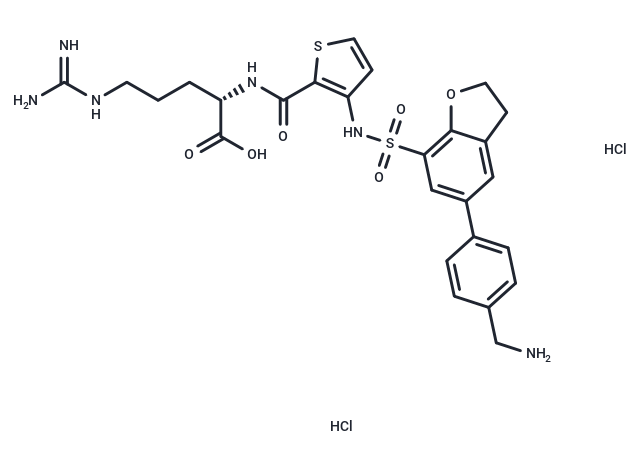Shopping Cart
Remove All Your shopping cart is currently empty
Your shopping cart is currently empty
EG01377 2HCl is a potent, bioavailable and selective inhibitor of neuropilin-1 (NRP1) with a Kd value of 1.32 μM and an IC50 value of 609 nM for both EG01377 2HCl against NRP1-a1 and NRP1-b1.EG01377 exhibits anti-angiogenic, antimigratory and antitumor activities.

| Pack Size | Price | USA Warehouse | Global Warehouse | Quantity |
|---|---|---|---|---|
| 1 mg | $123 | In Stock | In Stock | |
| 5 mg | $313 | In Stock | In Stock | |
| 10 mg | $479 | In Stock | In Stock | |
| 25 mg | $787 | In Stock | In Stock | |
| 50 mg | $987 | In Stock | In Stock | |
| 100 mg | $1,390 | - | In Stock | |
| 200 mg | $1,870 | - | In Stock | |
| 1 mL x 10 mM (in DMSO) | $455 | In Stock | In Stock |
| Description | EG01377 2HCl is a potent, bioavailable and selective inhibitor of neuropilin-1 (NRP1) with a Kd value of 1.32 μM and an IC50 value of 609 nM for both EG01377 2HCl against NRP1-a1 and NRP1-b1.EG01377 exhibits anti-angiogenic, antimigratory and antitumor activities. |
| Targets&IC50 | NRP1-a1 and NRP1-b:609 nM |
| In vitro | EG0 1377 2HCl (30 μM) effectively diminishes HUVEC cell migration induced by VEGFA. Additionally, EG01377 2HCl leads to reductions in network area, length, and branching points.[1] EG0 1377 2HCl (3-30 μM; 30 minutes) inhibits vascular endothelial growth factor A (VEGF-A) stimulated tyrosine phosphorylation of VEGF-R2/KDR with an IC50 of 30 μM.[1] EG0 1377 2HCl (30 μM; 5 days) can delay the VEGF-induced wound closure.[1] EG0 1377 2HCl diminishes VEGF-triggered angiogenesis. Moreover, when combined with VEGFA, EG01377 2HCl curtails spheroid outgrowth of A375P (malignant melanoma) cells.[1] EG0 1377 2HCl (500 nM; 2 h) blocks the production of transforming growth factor beta (TGFβ) by Nrp1+ regulatory T-cell SMAD3/AKT (Tregs) in the presence of tumor cell-derived factors.[1] |
| In vivo | EG0 1377 2HCl (2 mg/kg; i.v.; BABL/c female mice) possesses a half-life of 4.29 hours, allowing for once-a-day dosing to be maintained in mice.[1] |
| Synonyms | EG01377 2HCl(2227996-00-9 Free base) |
| Molecular Weight | 659.6 |
| Formula | C26H32Cl2N6O6S2 |
| Cas No. | 2749438-61-5 |
| Smiles | N=C(N)NCCC[C@@H](C(O)=O)NC(C(SC=C1)=C1NS(=O)(C2=C3C(CCO3)=CC(C4=CC=C(C=C4)CN)=C2)=O)=O.Cl.Cl |
| Relative Density. | no data available |
| Storage | Powder: -20°C for 3 years | In solvent: -80°C for 1 year | Shipping with blue ice/Shipping at ambient temperature. | |||||||||||||||||||||||||||||||||||
| Solubility Information | DMSO: 180 mg/mL (272.89 mM), Sonication is recommended. | |||||||||||||||||||||||||||||||||||
| In Vivo Formulation | 10% DMSO+40% PEG300+5% Tween 80+45% Saline: 5 mg/mL (7.58 mM), Sonication is recommended. Please add the solvents sequentially, clarifying the solution as much as possible before adding the next one. Dissolve by heating and/or sonication if necessary. Working solution is recommended to be prepared and used immediately. The formulation provided above is for reference purposes only. In vivo formulations may vary and should be modified based on specific experimental conditions. | |||||||||||||||||||||||||||||||||||
Solution Preparation Table | ||||||||||||||||||||||||||||||||||||
DMSO
| ||||||||||||||||||||||||||||||||||||
| Size | Quantity | Unit Price | Amount | Operation |
|---|

Copyright © 2015-2025 TargetMol Chemicals Inc. All Rights Reserved.